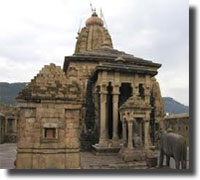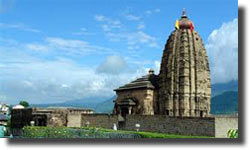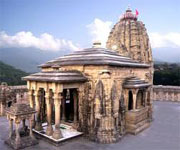Location :
Baijnath Temple is a very much revered and sacred shrine of Himachal Pradesh. which is located at a distance of 16 kms from Palampur in the Beas valley, the Temple is dedicated to Lord Shiva.
History of the Temple

There is a small porch in front of that mandapa hall that rests on four pillars in the front preceded by an idol of Nandi, the bull, in a small pillared shrine. The whole temple is enclosed by a high wall with entrances in the south and north while the outer walls of the temple have several niches with images of gods and goddesses. Numerous images are also fixed or carved in the walls. The outer doorway in the porch as also the inner doorway leading to the sanctum of the temple are also studded with a large number of images of great beauty and iconographic importance. Some of them are very rare to be found elsewhere.
Significance of the Temple
The Baijnath temple of Palampur was originally named as Kirangama and changed to Baijnath after dedicating the temple to Lord Shiva (Hindu Deity). Apart from the main deity, the temple even has the images of Goddess Chamunda, Surya (the Sun God), Kartikeya (son of Lord Shiva) and a massive structure of Nandi (Carrier of Lord Shiva) extremely in front of the Temple. One of the 12 Jyotirlingas are also located in the sanctum of this Baijnath temple. The temple holds much faith and is believed that, the 'Lord of Physicians' Shiva frees people from all kinds of ailments and diseases. Another interesting and spiritual fact of the temple lies in its water, as the water of the temple premises is considered to have curative and medicinal properties. Due to such spiritual and auspicious reasons, the temple still witnesses huge number of devotees every year. The 'Shivratri' festival is celebrated during the month of March and tourists throng to this place to get blessings from Lord Shiva (Hindu Deity).

In the early 20th century, the temple suffered from an earthquake and the then Raja Sansar Chand made an effort to renovate the temple after the calamity. The temple complex acquired lush green gardens, which makes a perfect foreground to the ancient and unique structure of this temple. Baijnath temple is considered as a part of Indian Heritage, so security arrangements are made here to avoid any unwanted element.
Baijnath temple is constructed according to the Nagri style of architecture. The roof of the temple is in the shape of pyramid with 2.5 sq meters from inside and almost covering the area of 5.5 sq meters from outside the temple premises. The conical shaped dome (Mandap) of the temple gets support from the four artistic big pillars. The temple is a unique example of Kangra architect.
The Myth of the Temple
According to Hindu Mythology, Ravana the demon worshipped Lord Shiva in the Himalyas and to please him Ravan offered his heads in the fire of havan. Lord Shiva was pleased and asked Ravana for a wish. Ravana the great demon wanted to be invincible and immortal and also asked Shiva to accompany him to Lanka. Shiva agreed for it and became Ling and asked Ravana to carry him. Shiva also said that he should keep the Ling on the ground during his journey to Lanka. However on the way Ravana had to answer the nature's call so he handed over the Ling to one shepherd who could not hold it for long and kept it on the ground. Hence the Shiva Linga was established here in Baijnath. Since it was Ravana who brought Shiva Linga to Baijnath, the people here do not burn effigy of Ravana during Dussehra fesival.
Time to Visit
In winter near the Temple area the temperature can drop to freezing point when heavy woollens are required. During summer, the climate is mild and light woollens/cottons are recommended. Baijnath Tempe is situated at an altitude of 1125 m and the best time to visit the temple is all the year round.
Other places to Visit around Baijnath
Taragarh Palace - in those times the Muslims used this place to propagate the ideas of Islam and later in 1933 the 'Nawab of Bhavalpur' built a palace there, which was named as Alhilal. The place remained as the summer capital of the Nawab till 1947.
|
Sujanpur Tira -The historic town of Sujanpur Tira is known for its palace which is now in ruins built by Raja Sansar Chand. It more popular for the temples of Gauri Shankar, Murli Manohar and Narbadeshwar. There is the largest ground of Himachal Pradesh which is made use of as a meeting place and also for sports activities. Trilokpur is 41 km from Kangra which is a natural cave and it has attractive pillars of limestone on the floor of the cave by the percolation of water from the roof. It is like a stalagmite and the cave is dedicated to Shiva. |
Nearby tourist places to Baijnath Temple Chandigarh Kausani Kullu Kumaon |  |
How to reach the Temple
- Train facility is available from Pathankot to Paprola-Baijnath which runs on narrow gauge from Pathankot to Jogidernagar.The Nearest airport is Gaggal from Baijnath. The Indian Airlines flies to Dharamsala thrice a week from Delhi
- By Road - the Baijnath Temple is very well connected by all weather roads to Delhi via Chandigarh and to Manali via Mandi.The temple is even easily accessible via road from Dharamsala, Palampur, Kangra and all the major cities of Himachal Pradesh.
- Tourists can hire private taxis or take state transport buses to reach this holy destination of Himachal Pradesh.
- Reaching Baijnath Temple via road, rail or air is fairly easy as it is well connected to the nearby areas as well as the rest of the country.
- By Air- The closest airport is at Kullu, positioned 23 kms from here.
- Travelers coming by train may use the rail station of Kalka, 90 kms from here.
- Some other places nearby lare Delhi, Dehradun, Kullu, Chandigarh, Pathankot, Manali, Chail and Ambala which are 343 kms, 240 kms, 220 kms, 117 kms, 380 kms, 260 kms, 43 kms and 151 kms respectively via road.



